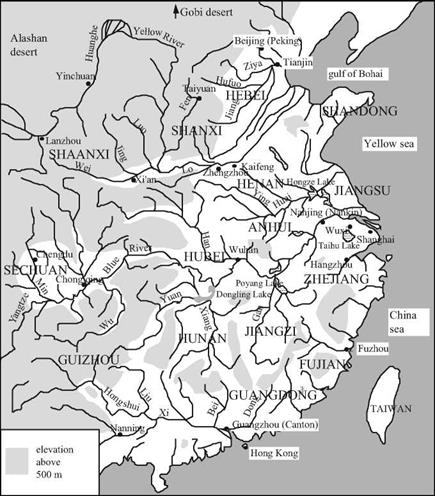From the beginnings of agriculture to the legendary founder of Chinese civilization
Archaeology teaches us that grain cultivation, namely millet, appears in the middle basin of the Yellow River around 6000 BC.[370] [371] [372] Two cultures develop successively in this region: one is called the Yangshao at the end of the VIth millennium BC, during which small- scale farming develops (pork, poultry); the other is the Longshan, at the end of the IIIrd millennium BC, during which wheat and barley develop in addition to millet, and the first fortified villages appear. As a point of reference, recall that this is also the period of the grand civilization of Harappa on the Indus and its extensions in Bactria. The Chinese regions involved are Shaanxi, Shandong and especially Henan and Shanxi. The foundation of Chinese civilization is rooted in the continuity of this culture, localized in
7 v 8
the region of the confluence of the Luo and the Wei rivers with the Yellow River. The legendary hero is Yu the Great who is said to have tamed the unpredictable course of the Yellow River through the construction of canals and deepening of its bed:
“Before him, the overflow waters flowed wantonly”[373]
It is of course, impossible to know if all the accomplishments attributed to Yu resulted from his efforts, or indeed from human intervention at all. But, given what we know and taking into account the seriousness of the ancient Chinese sources, there is no reason to doubt a priori the existence of the personage himself. He would be at the origin of the Xia Dynasty, whose domain scarcely extended beyond the terraces and valleys that mark the terminus of the middle course of the Yellow River. Taking the suggestions of the ancient Chinese historians to their logical conclusions, one ends up dating the legendary reign of Yu the Great to around 2200 or 2000 BC.
Civilization in China apparently begins two millennia after it began in Mesopotamia. On the other hand this Chinese civilization is remarkable for its durability, from its earliest beginnings up until the present day.
|
Figure 8.1. The eastern portion of China, showing the middle and lower courses of the Yellow River (Huanghe) and the Blue River (Yangtze). On this map, the rivercourses, coastlines, and city and province names are those of today. The Grand Canal is not shown. |







Leave a reply